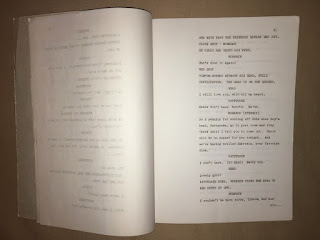The Oz books were one of the jewels of the Reilly & Britton publishing house, and the company was eager to promote the series. I occasionally run across other R & B titles showing ads for the works of their most famous author. Here are a couple examples of ads for Oz books, as well as other L. Frank Baum titles, featured on the jackets of other Reilly & Britton books. These jackets can be rather tattered, but I still find them interesting!
The back cover of
Fairy Tales From Shakespeare features what was then the entire Oz series, as published by Reilly & Britton.
The Sea Fairies, the start of Baum's new (and short-lived) Trot & Cap'n Bill series is given the front flap, while
The Juvenile Speaker is shown on the rear flap, making this a very Baum-ful jacket!
What Happened at Olenberg also featured a pair of Baum books;
The Sea Fairies again, and
The Daring Twins. This was to be the start of a series of young adult novels written under Baum's own name, but it only lasted for two books. However,
Aunt Jane's Nieces was shown on the rear of the jacket. This young adult series, written by Baum under the pseudonym of Edith Van Dyne, was quite successful!
An ad similar to those published within the Oz books was used on the rear of
Betty's Policeman. The titles list up to
Lost Princess, dating this jacket to 1917. The flaps contain no ads.
Azalea was another Reilly & Britton series, written by Elia Peattie, which ran to four titles.
The Daring Twins is featured prominently on the rear cover, this time with both titles in the series, while
Aunt Jane is on the rear flap. The front flap of the jacket contains a synopsis of the book. A later title from the series features all ten Aunt Jane books on the rear cover.
And finally,
Captain Becky's Masquerade has prominent ads for two of Baum's series written under the Edith Van Dyne pseudonym -
Aunt Jane's Nieces and
The Flying Girl. The Captain Becky books were written by Margaret Love Sanderson, and only ran to two titles - as did the Flying Girl series!
 A while back, (2013) I posted a photo of the Scarecrow and Tin Man from the Broadway Wizard of Oz musical. I identified them as Fred Stone and David Montgomery, the creators of the roles, but it now seems apparent that this isn't the case.
A while back, (2013) I posted a photo of the Scarecrow and Tin Man from the Broadway Wizard of Oz musical. I identified them as Fred Stone and David Montgomery, the creators of the roles, but it now seems apparent that this isn't the case. David Maxine contacted me recently with further information on the identity of the performers, from research he has done on the show. It appears that they are actually George Stone (no relation to Fred!) and Charles Wilkins.
David Maxine contacted me recently with further information on the identity of the performers, from research he has done on the show. It appears that they are actually George Stone (no relation to Fred!) and Charles Wilkins.









































